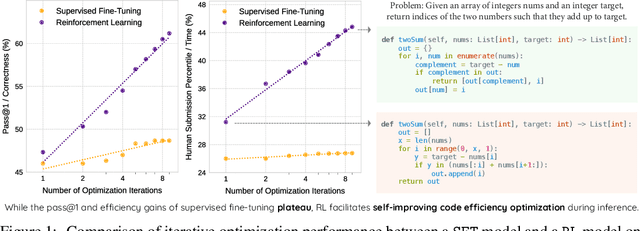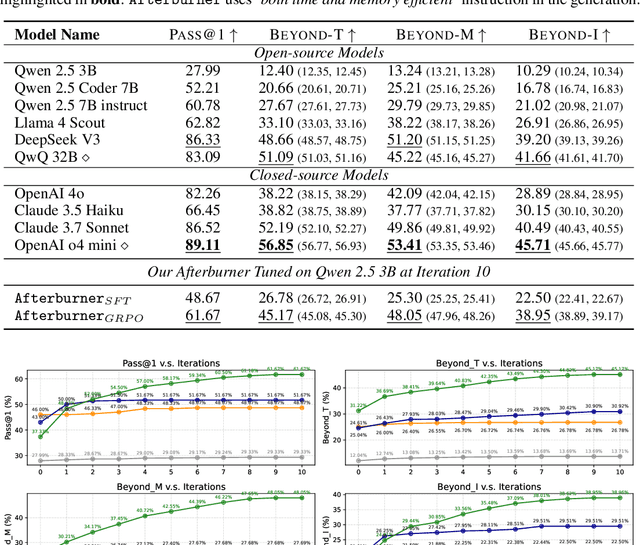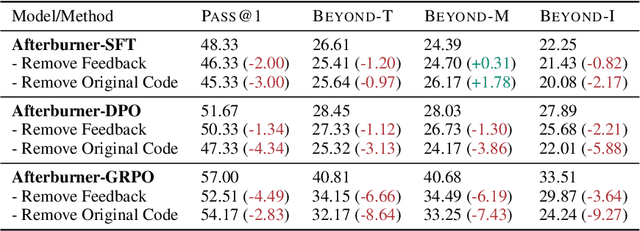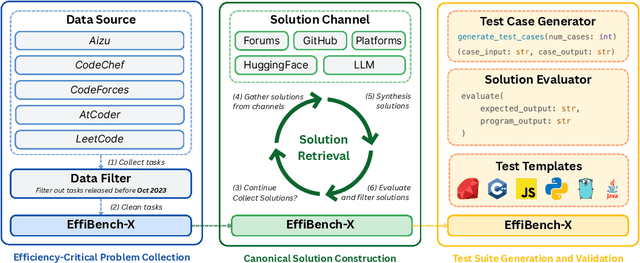Dong Huang
Nexus: Execution-Grounded Multi-Agent Test Oracle Synthesis
Oct 30, 2025Abstract:Test oracle generation in non-regression testing is a longstanding challenge in software engineering, where the goal is to produce oracles that can accurately determine whether a function under test (FUT) behaves as intended for a given input. In this paper, we introduce Nexus, a novel multi-agent framework to address this challenge. Nexus generates test oracles by leveraging a diverse set of specialized agents that synthesize test oracles through a structured process of deliberation, validation, and iterative self-refinement. During the deliberation phase, a panel of four specialist agents, each embodying a distinct testing philosophy, collaboratively critiques and refines an initial set of test oracles. Then, in the validation phase, Nexus generates a plausible candidate implementation of the FUT and executes the proposed oracles against it in a secure sandbox. For any oracle that fails this execution-based check, Nexus activates an automated selfrefinement loop, using the specific runtime error to debug and correct the oracle before re-validation. Our extensive evaluation on seven diverse benchmarks demonstrates that Nexus consistently and substantially outperforms state-of-theart baselines. For instance, Nexus improves the test-level oracle accuracy on the LiveCodeBench from 46.30% to 57.73% for GPT-4.1-Mini. The improved accuracy also significantly enhances downstream tasks: the bug detection rate of GPT4.1-Mini generated test oracles on HumanEval increases from 90.91% to 95.45% for Nexus compared to baselines, and the success rate of automated program repair improves from 35.23% to 69.32%.
Sample Efficient Experience Replay in Non-stationary Environments
Sep 18, 2025Abstract:Reinforcement learning (RL) in non-stationary environments is challenging, as changing dynamics and rewards quickly make past experiences outdated. Traditional experience replay (ER) methods, especially those using TD-error prioritization, struggle to distinguish between changes caused by the agent's policy and those from the environment, resulting in inefficient learning under dynamic conditions. To address this challenge, we propose the Discrepancy of Environment Dynamics (DoE), a metric that isolates the effects of environment shifts on value functions. Building on this, we introduce Discrepancy of Environment Prioritized Experience Replay (DEER), an adaptive ER framework that prioritizes transitions based on both policy updates and environmental changes. DEER uses a binary classifier to detect environment changes and applies distinct prioritization strategies before and after each shift, enabling more sample-efficient learning. Experiments on four non-stationary benchmarks demonstrate that DEER further improves the performance of off-policy algorithms by 11.54 percent compared to the best-performing state-of-the-art ER methods.
LEED: A Highly Efficient and Scalable LLM-Empowered Expert Demonstrations Framework for Multi-Agent Reinforcement Learning
Sep 18, 2025Abstract:Multi-agent reinforcement learning (MARL) holds substantial promise for intelligent decision-making in complex environments. However, it suffers from a coordination and scalability bottleneck as the number of agents increases. To address these issues, we propose the LLM-empowered expert demonstrations framework for multi-agent reinforcement learning (LEED). LEED consists of two components: a demonstration generation (DG) module and a policy optimization (PO) module. Specifically, the DG module leverages large language models to generate instructions for interacting with the environment, thereby producing high-quality demonstrations. The PO module adopts a decentralized training paradigm, where each agent utilizes the generated demonstrations to construct an expert policy loss, which is then integrated with its own policy loss. This enables each agent to effectively personalize and optimize its local policy based on both expert knowledge and individual experience. Experimental results show that LEED achieves superior sample efficiency, time efficiency, and robust scalability compared to state-of-the-art baselines.
RCR-Router: Efficient Role-Aware Context Routing for Multi-Agent LLM Systems with Structured Memory
Aug 06, 2025Abstract:Multi-agent large language model (LLM) systems have shown strong potential in complex reasoning and collaborative decision-making tasks. However, most existing coordination schemes rely on static or full-context routing strategies, which lead to excessive token consumption, redundant memory exposure, and limited adaptability across interaction rounds. We introduce RCR-Router, a modular and role-aware context routing framework designed to enable efficient, adaptive collaboration in multi-agent LLMs. To our knowledge, this is the first routing approach that dynamically selects semantically relevant memory subsets for each agent based on its role and task stage, while adhering to a strict token budget. A lightweight scoring policy guides memory selection, and agent outputs are iteratively integrated into a shared memory store to facilitate progressive context refinement. To better evaluate model behavior, we further propose an Answer Quality Score metric that captures LLM-generated explanations beyond standard QA accuracy. Experiments on three multi-hop QA benchmarks -- HotPotQA, MuSiQue, and 2WikiMultihop -- demonstrate that RCR-Router reduces token usage (up to 30%) while improving or maintaining answer quality. These results highlight the importance of structured memory routing and output-aware evaluation in advancing scalable multi-agent LLM systems.
Afterburner: Reinforcement Learning Facilitates Self-Improving Code Efficiency Optimization
May 29, 2025



Abstract:Large Language Models (LLMs) generate functionally correct solutions but often fall short in code efficiency, a critical bottleneck for real-world deployment. In this paper, we introduce a novel test-time iterative optimization framework to address this, employing a closed-loop system where LLMs iteratively refine code based on empirical performance feedback from an execution sandbox. We explore three training strategies: Supervised Fine-Tuning (SFT), Direct Preference Optimization (DPO), and Group Relative Policy Optimization~(GRPO). Experiments on our Venus dataset and the APPS benchmark show that SFT and DPO rapidly saturate in efficiency gains. In contrast, GRPO, using reinforcement learning (RL) with execution feedback, continuously optimizes code performance, significantly boosting both pass@1 (from 47% to 62%) and the likelihood of outperforming human submissions in efficiency (from 31% to 45%). Our work demonstrates effective test-time code efficiency improvement and critically reveals the power of RL in teaching LLMs to truly self-improve code efficiency.
Structured Agent Distillation for Large Language Model
May 20, 2025



Abstract:Large language models (LLMs) exhibit strong capabilities as decision-making agents by interleaving reasoning and actions, as seen in ReAct-style frameworks. Yet, their practical deployment is constrained by high inference costs and large model sizes. We propose Structured Agent Distillation, a framework that compresses large LLM-based agents into smaller student models while preserving both reasoning fidelity and action consistency. Unlike standard token-level distillation, our method segments trajectories into {[REASON]} and {[ACT]} spans, applying segment-specific losses to align each component with the teacher's behavior. This structure-aware supervision enables compact agents to better replicate the teacher's decision process. Experiments on ALFWorld, HotPotQA-ReAct, and WebShop show that our approach consistently outperforms token-level and imitation learning baselines, achieving significant compression with minimal performance drop. Scaling and ablation results further highlight the importance of span-level alignment for efficient and deployable agents.
EffiBench-X: A Multi-Language Benchmark for Measuring Efficiency of LLM-Generated Code
May 19, 2025



Abstract:Existing code generation benchmarks primarily evaluate functional correctness, with limited focus on code efficiency and often restricted to a single language like Python. To address this gap, we introduce EffiBench-X, the first multi-language benchmark designed to measure the efficiency of LLM-generated code. EffiBench-X supports Python, C++, Java, JavaScript, Ruby, and Golang. It comprises competitive programming tasks with human-expert solutions as efficiency baselines. Evaluating state-of-the-art LLMs on EffiBench-X reveals that while models generate functionally correct code, they consistently underperform human experts in efficiency. Even the most efficient LLM-generated solutions (Qwen3-32B) achieve only around \textbf{62\%} of human efficiency on average, with significant language-specific variations. LLMs show better efficiency in Python, Ruby, and JavaScript than in Java, C++, and Golang. For instance, DeepSeek-R1's Python code is significantly more efficient than its Java code. These results highlight the critical need for research into LLM optimization techniques to improve code efficiency across diverse languages. The dataset and evaluation infrastructure are submitted and available at https://github.com/EffiBench/EffiBench-X.git and https://huggingface.co/datasets/EffiBench/effibench-x.
M2Rec: Multi-scale Mamba for Efficient Sequential Recommendation
May 07, 2025Abstract:Sequential recommendation systems aim to predict users' next preferences based on their interaction histories, but existing approaches face critical limitations in efficiency and multi-scale pattern recognition. While Transformer-based methods struggle with quadratic computational complexity, recent Mamba-based models improve efficiency but fail to capture periodic user behaviors, leverage rich semantic information, or effectively fuse multimodal features. To address these challenges, we propose \model, a novel sequential recommendation framework that integrates multi-scale Mamba with Fourier analysis, Large Language Models (LLMs), and adaptive gating. First, we enhance Mamba with Fast Fourier Transform (FFT) to explicitly model periodic patterns in the frequency domain, separating meaningful trends from noise. Second, we incorporate LLM-based text embeddings to enrich sparse interaction data with semantic context from item descriptions. Finally, we introduce a learnable gate mechanism to dynamically balance temporal (Mamba), frequency (FFT), and semantic (LLM) features, ensuring harmonious multimodal fusion. Extensive experiments demonstrate that \model\ achieves state-of-the-art performance, improving Hit Rate@10 by 3.2\% over existing Mamba-based models while maintaining 20\% faster inference than Transformer baselines. Our results highlight the effectiveness of combining frequency analysis, semantic understanding, and adaptive fusion for sequential recommendation. Code and datasets are available at: https://anonymous.4open.science/r/M2Rec.
Robust Deep Reinforcement Learning in Robotics via Adaptive Gradient-Masked Adversarial Attacks
Mar 26, 2025Abstract:Deep reinforcement learning (DRL) has emerged as a promising approach for robotic control, but its realworld deployment remains challenging due to its vulnerability to environmental perturbations. Existing white-box adversarial attack methods, adapted from supervised learning, fail to effectively target DRL agents as they overlook temporal dynamics and indiscriminately perturb all state dimensions, limiting their impact on long-term rewards. To address these challenges, we propose the Adaptive Gradient-Masked Reinforcement (AGMR) Attack, a white-box attack method that combines DRL with a gradient-based soft masking mechanism to dynamically identify critical state dimensions and optimize adversarial policies. AGMR selectively allocates perturbations to the most impactful state features and incorporates a dynamic adjustment mechanism to balance exploration and exploitation during training. Extensive experiments demonstrate that AGMR outperforms state-of-the-art adversarial attack methods in degrading the performance of the victim agent and enhances the victim agent's robustness through adversarial defense mechanisms.
State-Aware Perturbation Optimization for Robust Deep Reinforcement Learning
Mar 26, 2025Abstract:Recently, deep reinforcement learning (DRL) has emerged as a promising approach for robotic control. However, the deployment of DRL in real-world robots is hindered by its sensitivity to environmental perturbations. While existing whitebox adversarial attacks rely on local gradient information and apply uniform perturbations across all states to evaluate DRL robustness, they fail to account for temporal dynamics and state-specific vulnerabilities. To combat the above challenge, we first conduct a theoretical analysis of white-box attacks in DRL by establishing the adversarial victim-dynamics Markov decision process (AVD-MDP), to derive the necessary and sufficient conditions for a successful attack. Based on this, we propose a selective state-aware reinforcement adversarial attack method, named STAR, to optimize perturbation stealthiness and state visitation dispersion. STAR first employs a soft mask-based state-targeting mechanism to minimize redundant perturbations, enhancing stealthiness and attack effectiveness. Then, it incorporates an information-theoretic optimization objective to maximize mutual information between perturbations, environmental states, and victim actions, ensuring a dispersed state-visitation distribution that steers the victim agent into vulnerable states for maximum return reduction. Extensive experiments demonstrate that STAR outperforms state-of-the-art benchmarks.
 Add to Chrome
Add to Chrome Add to Firefox
Add to Firefox Add to Edge
Add to Edge